VMBS Envisioning New, Next-Generation Small Animal Teaching, Research Hospital
Story by Jennifer Gauntt, VMBS Communications
Explore a dynamic version of this story here.
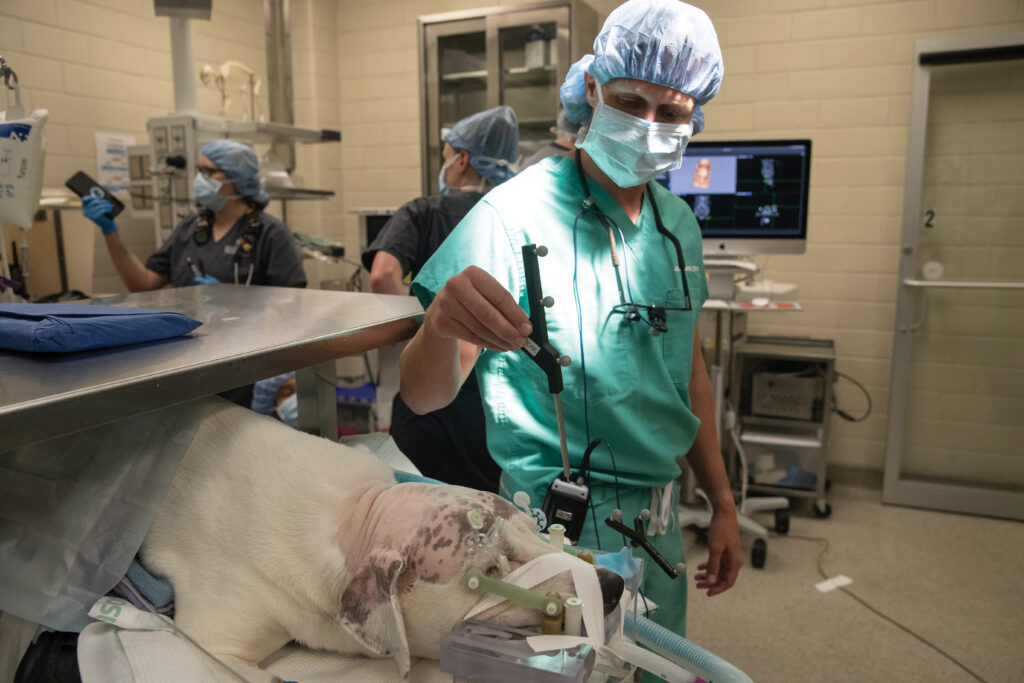
“When something has a champion, it moves,” said Dr. Jonathan Levine, head of the Small Animal Clinical Sciences Department (VSCS) in the Texas A&M School of Veterinary Medicine & Biomedical Sciences (VMBS).
What may seem like years in the making, the VMBS’ dream of a new, next-generation small animal teaching and research hospital has built momentum under Dr. John August, the Carl B. King Dean of Veterinary Medicine, and has quickly gained support from Texas A&M University President Dr. M. Katherine Banks.
“By having important conversations with the right stakeholders and administrators, Dean August has led these people who’ve been dreaming about a new small animal teaching and research hospital to develop it and run with it,” Levine said.
During her 2022 State of the University address, Banks referenced a new veterinary teaching and research hospital as a priority for the university, adding that the aspiration for this hospital is for it to be the best in the world.
“This hospital will provide hands-on educational workspace for veterinary students and a state-of-the-art laboratory for animal health and translational research,” she said during the address. “Faculty members in the vet school will partner with colleagues across the university to develop innovative diagnostic and therapeutic strategies.”
With several key milestones reached, the VMBS has forged ahead with developing a vision for a next-generation teaching and research hospital that builds on the school’s 100-plus years of excellence in teaching, service, and research, while keeping at heart Texas A&M’s core, land-grant mission and, above all, the university’s focus on student success.
A Solid Foundation
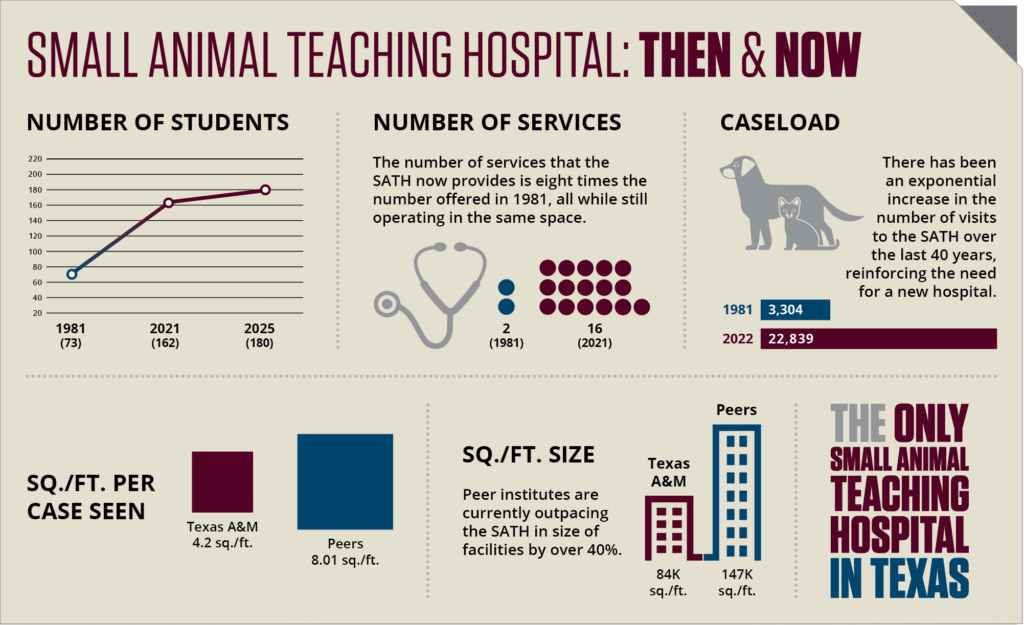
Among the reasons VMBS faculty, staff, students, and administrators have dreamed of a new small animal teaching and research hospital is that this facility is more than just a building—it’s a symbol of what could be, of boundless opportunities and possibilities.
It’s a dream that is driven by the interconnection between student success, leading-edge patient care, and clinical trials.
“Our vision is building upon strengths we already have,” Levine said. “The beautiful thing about it is that a lot of the pieces are here.”
“Our faculty, our students, and our staff—we can’t underscore the staff piece—are so passionate about what they do; their love for animals and the human-animal bond shines through,” said Dr. Stacy Eckman, associate dean for hospital operations.
“Clients see the rapport you build in the hospital, the expertise, and the passion when they walk in the door; they leave feeling like somebody deeply cared about them. It’s hard to put into words, but it’s a shared love for something; whether it’s healing the dog or the dog itself, it’s a shared passion.”
“The fact is that people do remarkable work in our Small Animal Teaching Hospital (SATH),” August said. “That’s the quandary (in needing a new teaching and research hospital)—the quality of work is amazing.”
That quality of work can be witnessed in many ways.
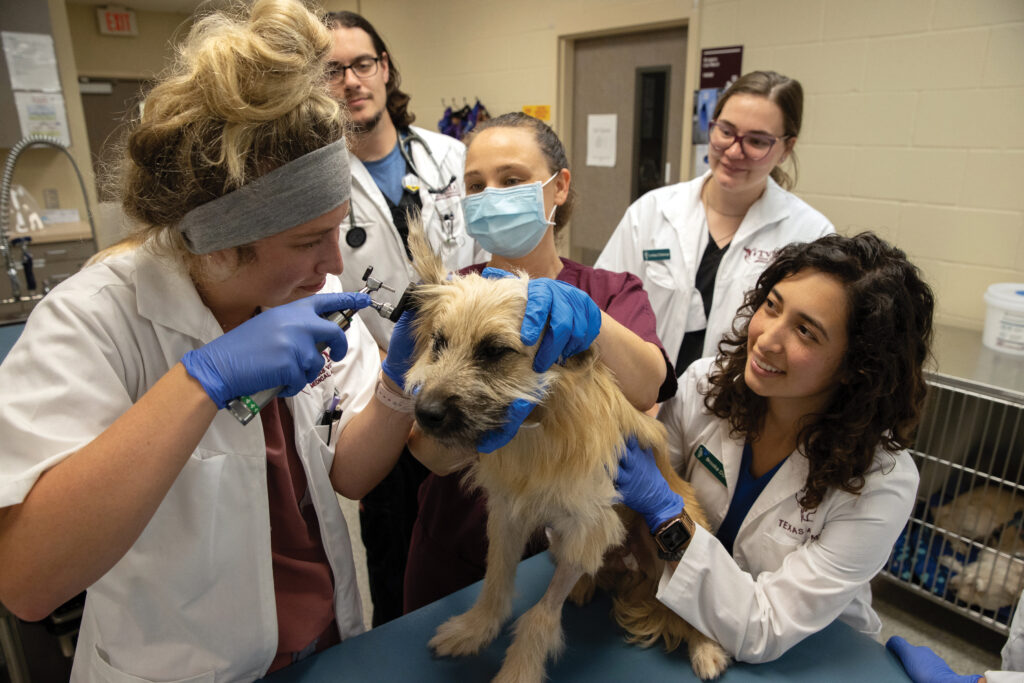
Chief among those are the exponential growth in caseload, which is more than six times higher than it was in 1981, when the current SATH was opened; the expansion of clinical research, with at least twice as many services offering clinical trials now compared to 10 years ago; and the increase in services themselves, from two in 1981 to 16 today.
All of these factors reflect the trust that clients have for SATH clinicians in caring for their beloved companion animals and the importance of the specialized care the SATH offers patients that is unavailable anywhere else.
Perhaps most importantly, these factors work together to ensure that VMBS students receive the exceptional education one expects from one of the most elite Doctor of Veterinary Medicine (DVM) programs in the country.
“It’s really all about the students. The teaching hospital is the pinnacle of their learning, and we have the only veterinary medical teaching hospital in Texas,” Eckman said. “We do an exceptional job of teaching clinical medicine.
“We gather a diverse caseload at the tertiary-care level, and while a lot of the cases are not necessarily things that students are going to be seeing in private practice, the exposure they get to a lot of different scenarios gives them the opportunity to practice everything all at once,” she said. “That is really critical when teaching students.”
A Bold Vision For The Future
Capitalizing on that good work and synergy means weighing how the SATH can both better serve Texas’ citizens and animals, as well as the students who begin their careers as Aggie veterinarians within the hospital’s walls—while also looking to the future.
“There’s this tremendous opportunity to do so much more,” Levine said. “We continue to innovate in the clinic with our interventional radiology, with our minimally invasive surgeries, with some procedures you can’t get anywhere else in the state and the U.S. This is about doing more of that; it’s about access.”
Programs like the VSCS’ Underserved Communities Internship—created to broaden the SATH’s reach across the state—and the Roach Family Student Community Outreach Surgical Program—which allows students to gain more surgical experience while offering free procedures for the pets of low-income Brazos Valley residents—are good examples of ways a new teaching hospital can combine education and patient care while looking to the future.
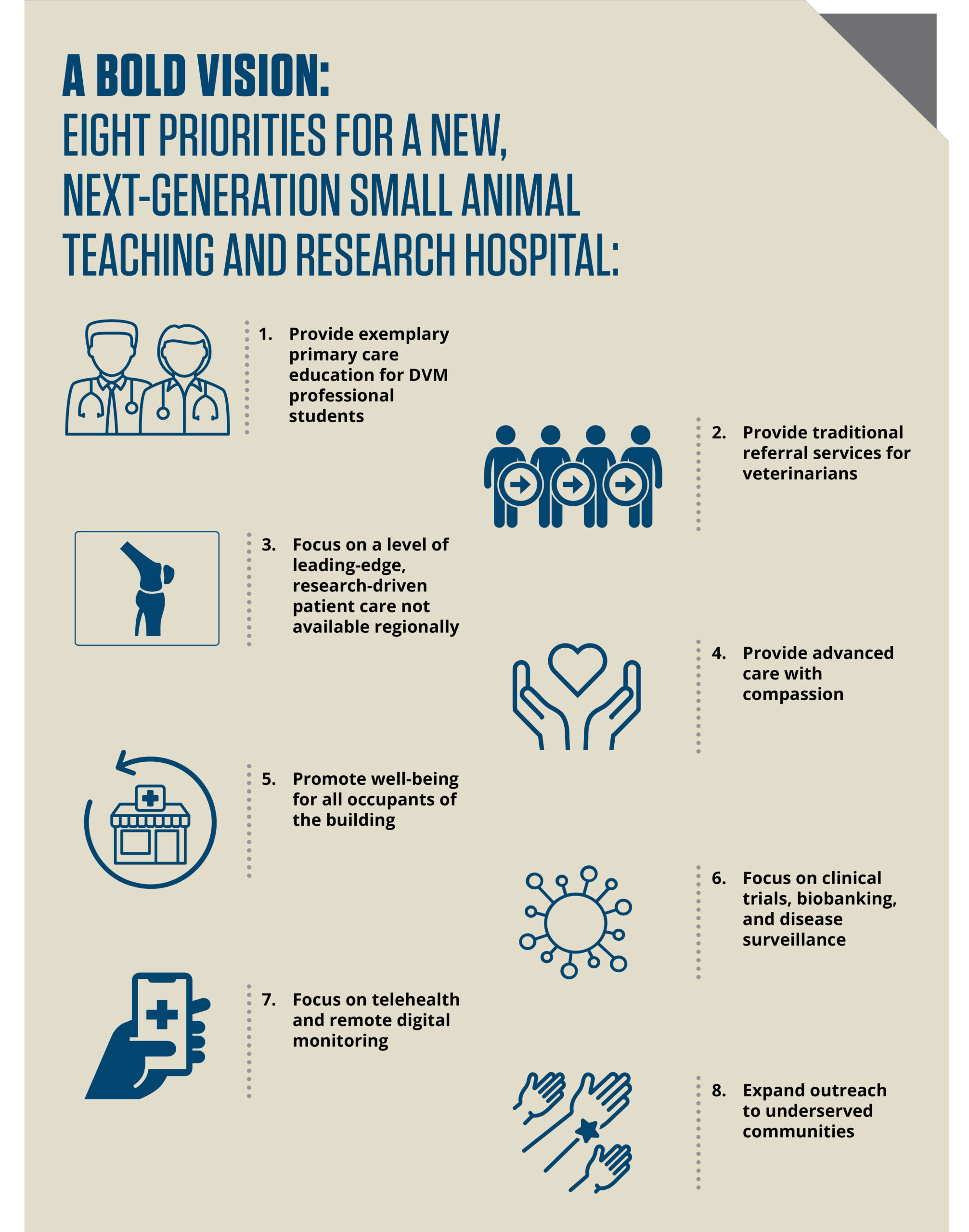
“Dean August has been particularly good about reminding us about the importance of the external impact we have through our students, through serving our state, and through innovating,” Levine said. “Where we see gaps, we’ve got to fill them. We must be thinking of big ideas; we should be working on a few each year that build on top of one another.”
Part of that impact, too, comes from research and clinical trials, which offer students insight into non-clinical veterinary career paths and showcase how research can offer real hope to animal owners, while also supporting the advancement of medicine that impacts animals and human beings.
For August, this combination of ideas prominently places the VMBS within Banks’ vision of a Texas A&M that stands at the forefront of medical and technological innovation.
“If we look at the Small Animal Teaching Hospital as a research-intensive tertiary care center, we can aspire to become a teaching and research hospital comparable to MD Anderson,” he said. “Nobody worries that MD Anderson is a research-driven hospital. You go there to be part of a clinical trial. You go there because it is the best in the world. You go there because it is cutting-edge. You go there because of the high level of compassionate care. People understand that’s the role A&M should have in the care of companion animals.”
Likewise, with other health- and medical-focused schools, colleges, and departments at Texas A&M, there is an abundance of mutually beneficial opportunities to collaborate on topics like medical devices and issues that directly impact both animals and human beings.
“We have an opportunity to look at what role a small animal teaching and research hospital should have within our research-intensive, land-grant institution that focuses on the life sciences, as Texas A&M University does,” August said.
“Since the Small Animal Teaching Hospital has opened, the number of referral hospitals in Texas and in the nation has exploded; we no longer need to view ourselves as just a referral hospital,” he said. “We have a very unique opportunity to collaborate with others at our university in those disciplines who share our interest in animal and human health and to develop a model for a small animal teaching and research hospital that is quite different from everything else that has been developed nationwide in the last decade.”
As Texas’ human and animal populations grow and projected spending within the pet industry nationwide swells to $250-300 billion by 2029, it will be more important than ever to have a flexible space where students can excel, clinicians can continue to provide leading-edge patient care, and basic and clinical scientists can come together to unravel some of life’s most pressing medical mysteries—while still being conscious that these increased needs will require more and more people to achieve these goals.
“Even though we are a tertiary care hospital, we want to keep looking for opportunities to impact the whole state,” Levine said.
Cramped Spaces
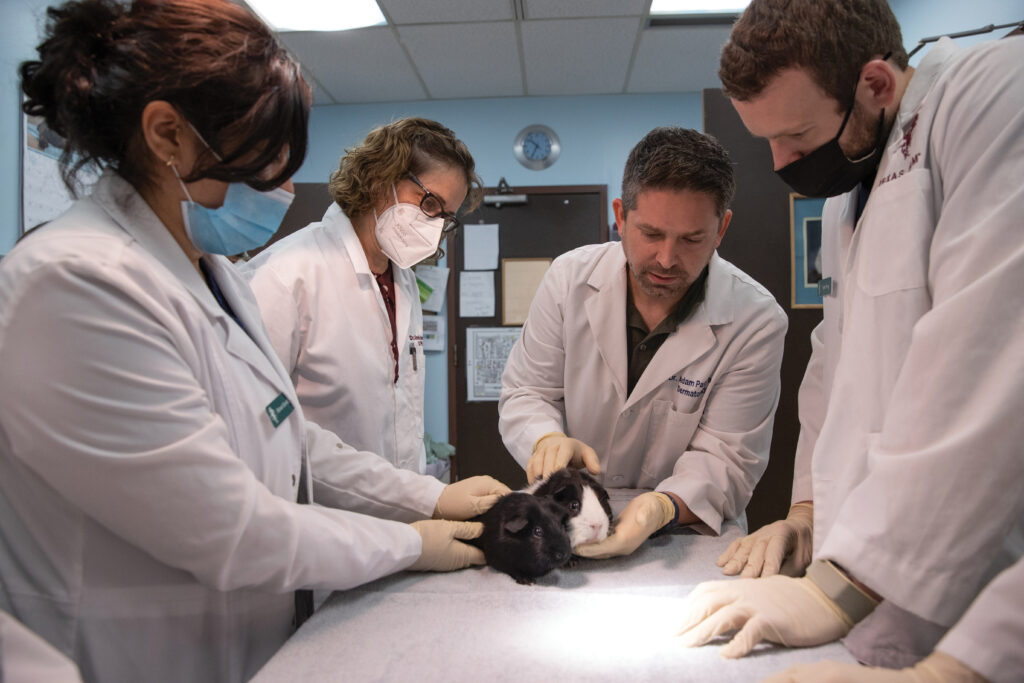
Eckman graduated from Texas A&M’s veterinary school in 2001, 20 years after the current SATH building opened. As a faculty member and now associate dean, Eckman says that a lot has changed at the SATH, but there’s one thing that hasn’t.
“The hospital is the same hospital,” she said. “That’s important because our faculty and staffing have grown exponentially and our student numbers have grown considerably, but we’re in the same exact footprint.”
August shared a similar experience when he joined the VMBS as head of the of the Department of Small Animal Medicine and Surgery in 1986.
“In some ways, the building was already outdated when I came here, even though it was quite new at that time,” he said. “It was designed to provide more space but not necessarily designed for the future. So, today, we have a 40-year-old building that doesn’t reflect the quality of the work going on inside.”
While those in the SATH are doing tremendous work, the current facility ranks at the bottom in nearly all criteria compared to peer institutions; the VMBS’ nationally ranked curriculum and exceptional patient care are being accomplished in cramped spaces that present both challenges in managing increasing caseloads and potential safety and biosecurity challenges that impact the school’s aspirations in teaching, patient care, and research.
That the SATH continues to literally push its boundaries speaks to the resiliency of the faculty, staff, and students, according to Levine.
“Our faculty, our students, and our staff are very flexible; they meet challenges with a can-do attitude,” Levine said. “That’s a little bit cliché, but to be able to achieve what they’ve achieved in those spaces, hats off to them.”
But the limitations that faculty, staff, and students experience are sometimes more than just an inconvenience.
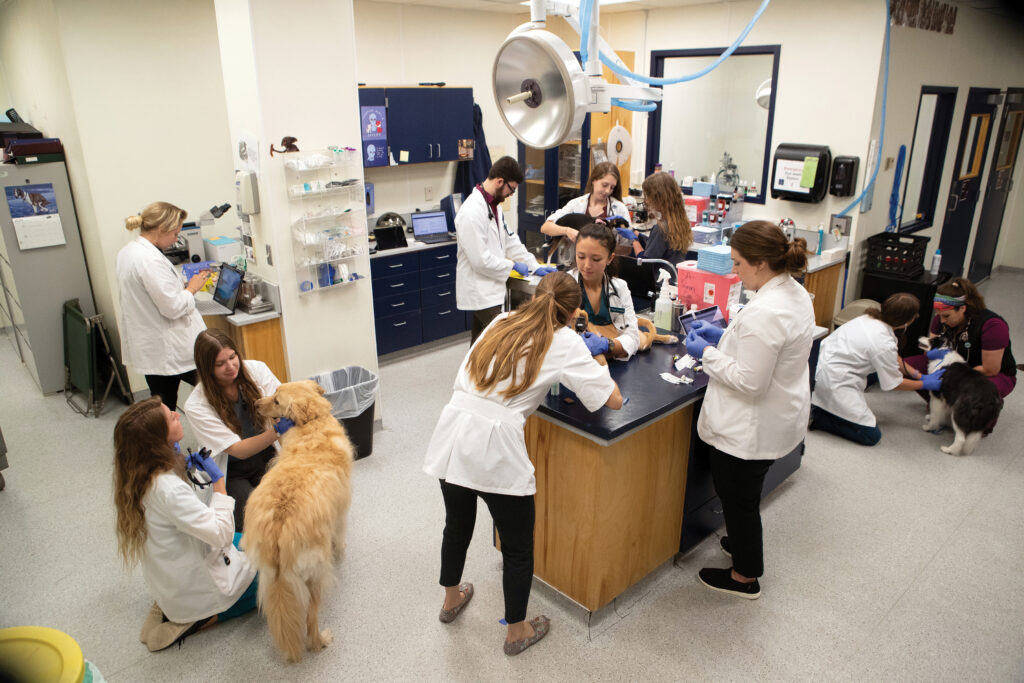
“We do have to divert cases periodically—every seven to 14 days, and sometimes more frequently—because we don’t have enough room in our ICU; we try to limit that as much as we can and our ER, of course, is still open for emergencies,” Eckman said. “But if we only have so much space, we can only see so many cases; above all, we need to guarantee that we have adequate space and resources to ensure we are providing the highest quality care.”
Weighing the impact of an overcrowded hospital on students is especially important, because it can be directly related to student success.
“As a clinician, if I think about a caseload I had when there were 132 students, I need to increase my caseload so that the 180 students get the same learning opportunities,” Eckman said. “If we’re limited on how many cases we can bring in and where we can put them, we have to be creative about how we’re teaching students. And if we have to say no to cases wanting to come in because we don’t have the space for them, it’s a lost opportunity.”
The limitations the SATH experiences are compounded by the increase in technology that has occurred in medicine since the 1980s.
“In the 80s, our operating rooms weren’t built for all of the scope towers and monitors,” Eckman said. “By the time you add equipment, the room has shrunk considerably; we have just far exceeded our capacity.
“Our ability to teach is still awesome. Our patient care is awesome,” she said. “But we can’t build on that right now. We can’t see more patients. We can’t teach differently. We can’t do any more research. We can’t do any more innovative surgeries. We can’t do any more in our current footprint.”
Room To Grow
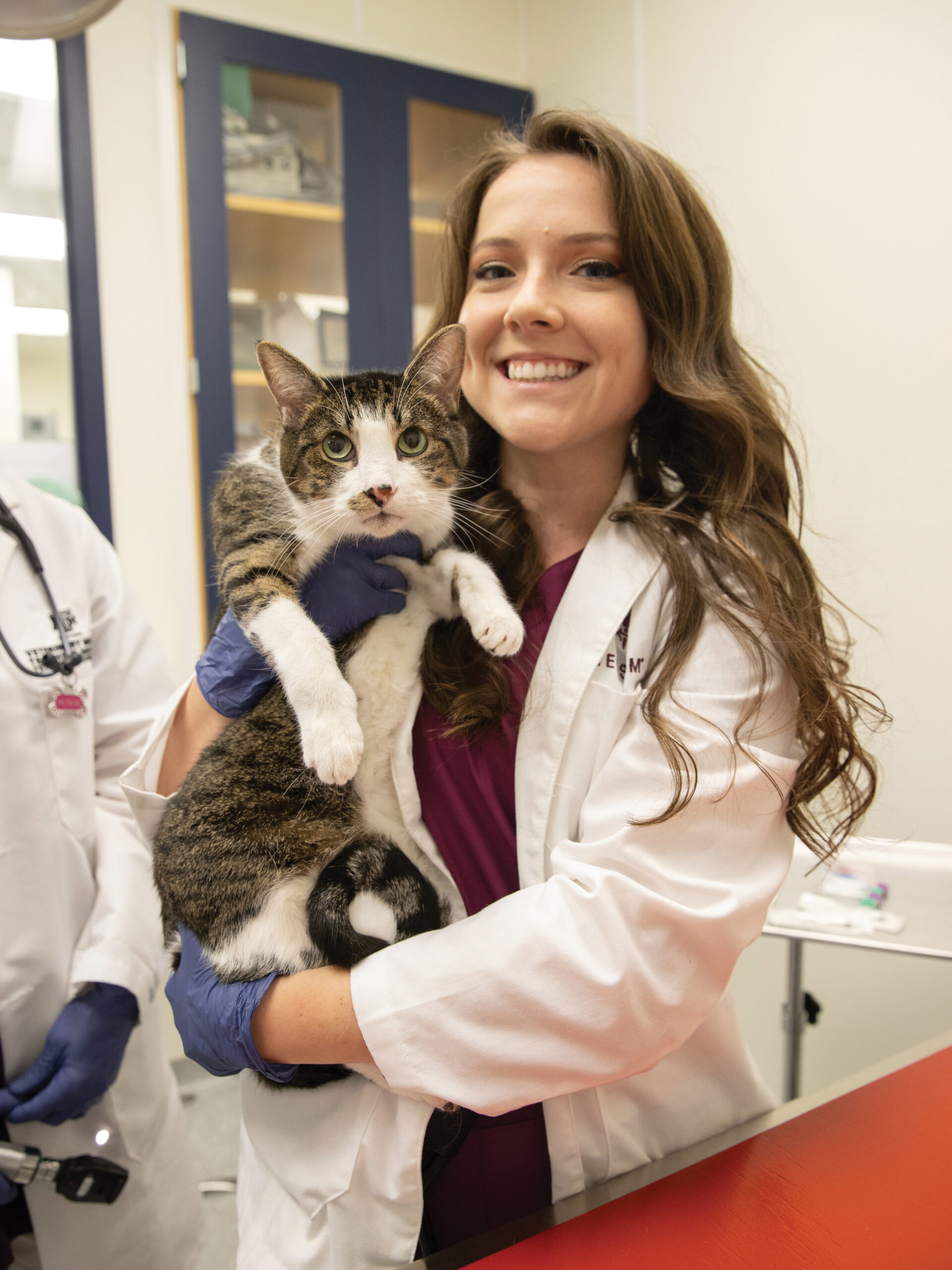
August sees the new small animal teaching and research hospital as having a unique opportunity to play a central role in the next phase of Texas A&M’s growth and stature.
“There was an attempt back in 2013 to expand the Small Animal Teaching Hospital. In the end, the finances weren’t there; they had to be put into the educational complex,” August said. “In many ways, it’s a godsend that we didn’t update or replace it 10 years ago, because it probably would’ve already been out of date.
“We have to make sure that the new hospital is designed in a way that we have flexibility over the next decades for handling the sickest, most complicated patients and not be faced with a situation where in five years we’re wishing our ICU was bigger,” he said.
“At the same time, we will need exceptional primary care space for client, patient, and student interaction, to provide adequate space for veterinary medical students to develop the foundational competencies needed before entering the profession with immediate confidence,” August continued.
Now that the project has support from Texas A&M’s president, the Texas A&M University System, and the Texas Legislature, the VMBS is looking ahead to the pieces that need to be completed before breaking ground—including submitting a program of requirements for approval by the Texas A&M System Board of Regents in February 2023, which will move the project into the engineering and architectural planning phases.
As the VMBS administrative and development teams work toward bringing the school’s dream to fruition, with the hopes of hosting a ribbon-cutting ceremony by 2026, the support of donors will be critical.
“This new teaching hospital has the potential to have tremendous impact not only within Texas A&M but outside as well. Institutions exist for the positive impact they have on society at large,” Levine said. “We’re going to be able to change not only the educational landscape for students preparing to enter the workforce, not only the pet health care landscape, but, also, there may be some real scientific innovation that comes along with it. So, I think it’s going to be amazing for donors as well.”
Join Texas A&M and the VMBS in laying the foundation for the next generation of exceptional student success, leading-edge patient care, and impactful research. Together, we can share the Aggie spirit with the world through the advancement of medicine that impacts animals and human beings. You can support the school’s mission through endowed funds for research, faculty, and student scholarships. Additionally, naming opportunities starting at $25,000 abound in the new facility, and spaces can be named in memory or honor of a special person or pet.
If you’d like to be part of pushing veterinary medicine to new heights at Texas A&M, contact Larry Walker ’97, the Assistant Vice President of Development at the Texas A&M Foundation, at lwalker@txamfoundation.com.
Support construction with gifts of $25 or more online at tx.ag/NextGenVetHospital.
###
Note: This story originally appeared in the Winter 2023 edition of VMBS Today.
For more information about the Texas A&M College of Veterinary Medicine & Biomedical Sciences, please visit our website at vetmed.tamu.edu or join us on Facebook, Instagram, and Twitter.
Contact Information: Jennifer Gauntt, Director of VMBS Communications, Texas A&M College of Veterinary Medicine & Biomedical Sciences; jgauntt@cvm.tamu.edu; 979-862-4216


